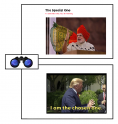One or other, both or neither?
[ by Charles Cameron — Modi or Trump, special or chosen? — with thanks to The Emissary on BrownPundits — and closing in on the shining suchness of the Tathagata ]
.
Modi of India, Trump of USA?

**
Trump of USA proclaims himself the Chosen One, while Modi of India’s supporters claim Modi is the Special One.
Who knew?
**
Sources:
**
Buddhist logic from the beginning differs from its Aristotelian cousin, featuring the chatushkoti or tetralemma:
India in the fifth century BCE, the age of the historical Buddha, and a rather peculiar principle of reasoning appears to be in general use. This principle is called the catuskoti, meaning ‘four corners’. It insists that there are four possibilities regarding any statement: it might be true (and true only), false (and false only), both true and false, or neither true nor false.
Hence my title, One or other, both or neither?
speaking of the Buddha, Nagarjuna states that the Buddha’s teaching is “emptiness is suchness, not suchness, both suchness and not suchness, and neither suchness nor not suchness.”
Furthermore:
The suchness of the Tathagata is the suchness of all phenomena.
Rumor therefore has it that there’s a fifth possibility, a refuge from all dualities: the shining suchness of the Tathagata.
**
No, really — please comment!
Stephen Calhoun:
February 4th, 2020 at 10:19 pm
Once again I am reminded that an actual paradox is actually paradoxical.
Here’s a useful modification.
Are you a believer?
Yes
No
Yes and No
All of the above
bonus: my artwork Tetralemma https://artiststephencalhoun.com/tetralemma/
Happy new year Charles!
Greg McMurray:
February 5th, 2020 at 2:51 am
Tetralemma reminds me of something I read the other day concerning St Teresa of Avila. Charles, you and the other readers may find this of interest, the holy headache of Donald Trump,
https://nationalpost.com/opinion/raymond-de-souza-christianity-and-the-holy-headache-of-donald-trump
.
I’m not sure what to make of a compromise between religion and politics, but I like the advice at the end. St. Teresa often mentioned her spiritual teachers in her writings, dividing them into the ones that were learned and the ones that were holy (she also mentions virtuous, but that is a different element for another day). St. Teresa suggests that, while it’s best to be advised by a teacher that is both learned and holy, the real practice of spirituality and prayer usually put those qualities at odds. Due to various practical matters that cause us to fall short of the ideal, it’s better if the teacher is learned instead of holy, rather than holy but not learned.
.
A way of viewing this in contemporary terms might be when you see the modern, self-sufficient person describe themselves as ‘spiritual but not religious’. St. Teresa would go with the ones who are ‘religious but not spiritual’. Don’t let go of the rope, if you know what I mean.
.
So, further modifying the matrix to the following categories:
Learned
Holy
Both Learned and Holy
Neither Learned nor Holy
.
I will leave it up to you to decide if Trump is learned, but we can all agree that he isn’t holy. It becomes surprisingly clear in her works that St. Teresa, humble as she was, actually considered herself at the start of her spiritual journey to be in that last corner, unlearned and unholy. Perhaps that’s what led to her contemplative methods such as the prayer of recollection (taught to her by God Himself, how’s that for a spiritual teacher?) and the four waters. “A glorious foolishness, a heavenly madness, where true wisdom is learned,” as she so wonderfully described it. Vaulting off the fourth quadrant straight to transcendence of the dualities and/or/neither the quadalities.
Charles Cameron:
February 5th, 2020 at 4:09 am
Here’s a reduced image of my old friend Stephen Calhoun’s photo-graphic %i(Tetralemma):

.
.
A laerger version of the image can be foubd at his link above.
Charles Cameron:
February 5th, 2020 at 4:24 am
A sort of tetralemma dilemma:
.
You’re a science teacher, teaching Schrodinger’s cat, and the way you phrase your teaching may slip from your mouth without too much thought. So which do you say? And what are the implications of your choice?
.
Is Schrodinger’s cat (a) both alive and dead, or (b) either alive or dead — in either case, we don’t know which?
Sally Benzon:
February 6th, 2020 at 1:59 am
I really appreciate the comment above about St. Teresa of Avila. Thank you! And Happy New Year to you, Charles!
Greg McMurray:
February 10th, 2020 at 1:28 am
Dear Sally, you’re quite welcome. I can never be certain if the affinity exists or if I’m just affinitizing instead (or both, or neither, haha). It is nice when someone else likes it too, regardless.